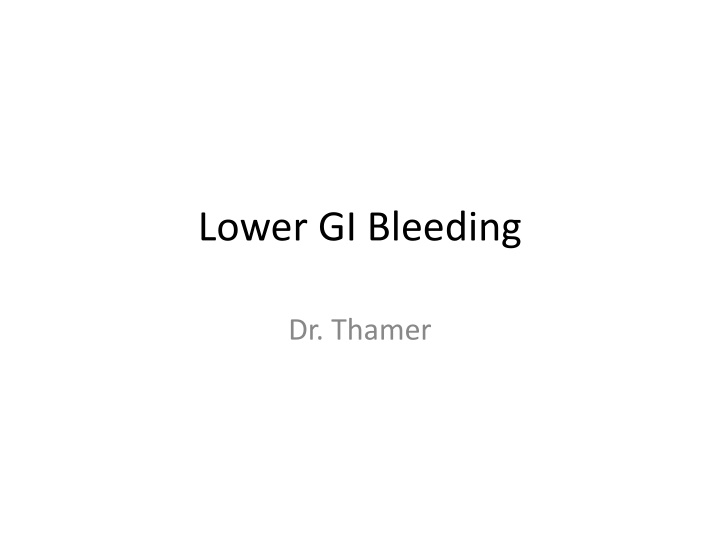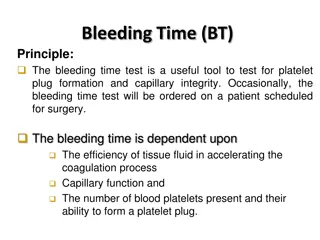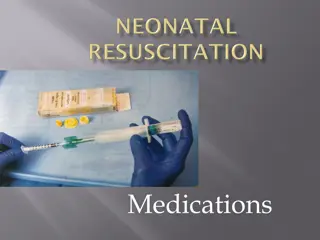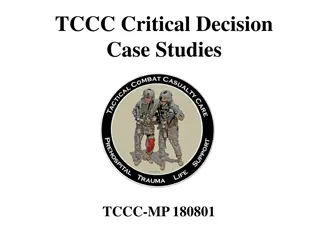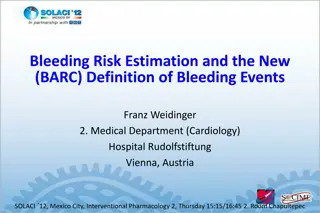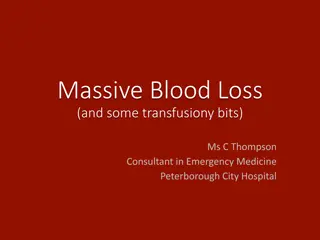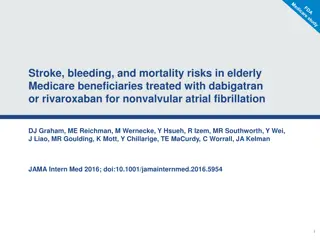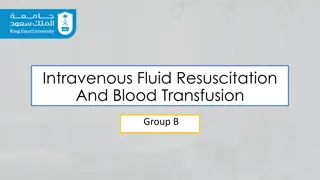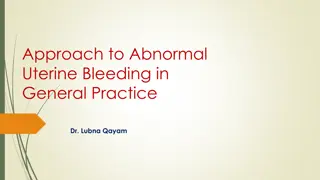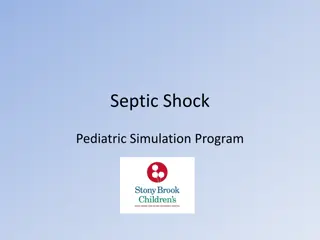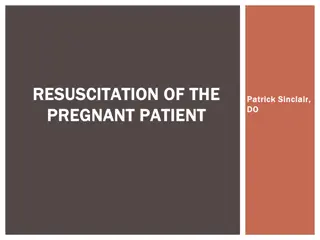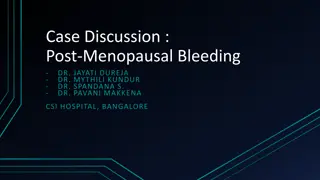Management of Lower GI Bleeding: Initial Evaluation and Resuscitation
Lower gastrointestinal bleeding, originating distal to the ligament of Treitz, often presents with overt or occult symptoms. Initial management involves hemodynamic stabilization, localization of the bleed site, and tailored therapeutic interventions. Key steps include IV fluid resuscitation, monitoring intravascular volume, blood product administration based on individual factors, focused history and physical examination, and consideration of upper GI endoscopy for diagnostic clues.
Download Presentation

Please find below an Image/Link to download the presentation.
The content on the website is provided AS IS for your information and personal use only. It may not be sold, licensed, or shared on other websites without obtaining consent from the author.If you encounter any issues during the download, it is possible that the publisher has removed the file from their server.
You are allowed to download the files provided on this website for personal or commercial use, subject to the condition that they are used lawfully. All files are the property of their respective owners.
The content on the website is provided AS IS for your information and personal use only. It may not be sold, licensed, or shared on other websites without obtaining consent from the author.
E N D
Presentation Transcript
Lower GI Bleeding Dr. Thamer
LGI Bleeding : Abnormal hemorrhage into the lumen of the bowel from a source distal to the ligament of Treitz. 95% from the colon . Up to 40% of patients with lower GI bleeding, more than one potential source of hemorrhage is identified.
Overt GI bleeding the presence of hematemesis, melena, or hematochezia. Occult GI the absence of overt bleeding and is identified on laboratory tests (e.g., iron- deficiency anemia) or examination of the stool (e.g., positive guaiac test). Obscure GI bleeding no source has been identified by routine endoscopic studies (EGD and colonoscopy). Obscure GI bleeding is occult in 20% of cases.
The basic components of management are 1. initial hemodynamic stabilization, 2. Localization of the bleeding site, and 3. Site-specific therapeutic intervention.
Initial Evaluation and Resuscitation Two large-bore peripheral IV catheters should be inserted and isotonic I.V. fluid administered. A Foley catheter should be placed to facilitate monitoring of intravascular volume status.
Whether and in what form to administer blood products is determined on an individual basis, with appropriate weight given to the presence or absence of comorbid conditions, the rate of blood loss, and the degree of hemodynamic stability. ICU monitoring in pt with HD instability .
Focused Hx and physical Ex , to be carried out simultaneously with resuscitation. nature and duration of bleeding, associated symptoms, past medical history, complicating comorbid conditions, medications postural vital signs, complete abdominal exam. laboratory tests (CBC, serum electrolytes, coagulation profile, and typing and cross matching). Place NG tube for gastric lavage.
If lavage yields positive results (i.e., the aspirate contains gross blood or coffee grounds),UGI scope. An aspirate that contains copious amounts of bile is strongly suggestive of a lower GI source. The choice is less clear-cut with a clear aspirate. In the absence of bile, such an aspirate cannot rule out a duodenal source for the bleeding.
So , depending on the overall clinical picture, the surgeon may choose either to perform EGD to rule out a duodenal bleeding source or to proceed with colonoscopy on the assumption that the source of the bleeding is in the lower GI tract.
Investigative Studies colonoscopy , radionuclide scanning, CT scan, and angiography (in the form of selective mesenteric arteriography). The goal of these tests is to locate the site of bleeding accurately so that definitive therapy can be properly directed.
Which diagnostic test is chosen for a specific patient depends on several factors, including the hemodynamic stability of the patient, the bleeding rate, the comorbid conditions present, and the local expertise available at the physician s hospital.
Colonoscopy Most appropriate in the setting of minimal to moderate bleeding Major hemorrhage interferes significantly with visualization, and the diagnostic yield is low. In addition, the unstable patient, sedation and manipulation may be associated with additional complications and can interfere with resuscitation. Although the blood is cathartic, gentle preparation with polyethylene glycol, either orally or through an NG tube, can improve visualization.
If the entire colon has been adequately visualized and no source for the bleeding has been identified, the ileum should be intubated; fresh blood in this region suggests a possible small bowel source. although this can be misleading because of retrograde peristalsis in the colon.
Overall diagnostic yields ranging from 53% to 97%. An average complication rate of 0.5%. Colonoscopy has both a higher diagnostic yield and a lower complication rate than arteriography in this setting and thus would appear to be a more attractive initial test in most circumstances.
If no active bleeding is observed in the ileum, upper GI endoscopy should be performed to rule out an upper GI bleeding site. When colonoscopy and routine upper GI endoscopy fail to locate a bleeding source, push enteroscopy may be helpful. It can be performed purely endoscopically with a pediatric colonoscope .
In the OR during exploratory laparotomy. The surgeon can manually milk the small bowel over the scope to evaluate its distal portion or through an enterotomy and the scope can be passed in both a retrograde and an antegrade fashion .
Radionuclide Scanning Two imaging tracers, both labeled with technetium-99m (99mTc), are currently available for radionuclide scanning in this setting: 99mTc-labeled sulfur colloid (99mTc-SC) and 99mTc-labeled red blood cells (RBCs).
99mTc-SC requires no preparation time and can be injected immediately into the patient; Its rapid absorption into the liver and the spleen can often hinder accurate localization of overlying bleeding sites.
99mTc-labeled RBCs. Requires some preparation time, Longer half-life than 99mTc-SC does, Not taken up by the liver and spleen, and It can be detected on images as long as 24 to 48 hours after injection .
99mTc-labeled RBCs is the most sensitive but least accurate method for localization of GI bleeding. The patient's own RBCs are labeled and re injected. The labeled blood is extravasated into the GI tract lumen, creating a focus that can be detected scintigraphically.
Initially, images are collected frequently and then at 4 hour intervals for up to 24 hours. The tagged RBC scan can detect bleeding as slow as 0.1 mL/min and is reported to be more than 90% sensitivity.
Accuracy of localization is in the range of only 40% to 60%, and it is particularly inaccurate in distinguishing right- from left-sided colonic bleeding.
The RBC scan is not usually employed as a definitive study before surgery but instead as a guide to the utility of angiography; if the RBC scan is negative or only positive after several hours, angiography is unlikely to be revealing. Such an approach avoids the significant morbidity of the angiogram.
COMPUTED TOMOGRAPHY CT scanners were able to detect arterial bleeding at rates as low as 0.07 ml/min, which suggests that CT scanning is more sensitive than angiography for this purpose. In addition, CT scans are noninvasive and carry little morbidity. Unfortunately, like radionuclide scanning, CT has no therapeutic capability & the use of CT in this setting is the excessive dye load if angiography is employed as well.
Mesenteric Angiography Can detect hemorrhage in the range of 0.5 to 1.0 mL/min and is generally only employed in the diagnosis of ongoing hemorrhage. It can be particularly useful in identifying the vascular patterns of angiodysplasias or localizing actively bleeding diverticula. It has therapeutic capability .
Catheter-directed vasopressin infusion can provide temporary control of bleeding, permitting hemodynamic stabilization . It can also be employed for embolization.
Infusion of vasopressin is initiated at a rate of 0.2 U/min and can be increased to a rate of 0.4 U/min. Within 20 to 30 minutes, another angiogram is performed to determine whether the bleeding has ceased. If the bleeding is under control, the catheter is left in place and vasopressin is continuously infused for 6 to 12 hours. If the bleeding continues to be controlled, infusion is continued for an additional 6 to 12 hours at 50% of the previous rate. Finally, vasopressin infusion is replaced by continuous saline infusion, and if bleeding does not recur, the catheter is removed.
Systemic side effects, including myocardial ischemia, peripheral ischemia, hypertension, dysrhythmias, mesenteric thrombosis, intestinal infarction, and death. Occasionally, simultaneous I.V. administration of nitroglycerin is necessary to counteract these systemic effects.
The reported success rate of vasopressin in controlling lower GI bleeding ranges from 60% to 100%, and the incidence of major complications ranges from 10% to 20%. 50% of patients experience re bleeding when the medication is discontinued.
Typically, such therapy is reserved for patients whose underlying condition precludes surgical therapy. Unfortunately, angiography is associated with a significant risk for complications, including hematomas, arterial thrombosis, contrast reactions, and acute renal failure.
An alternative for patients with coronary vascular disease, severe peripheral vascular disease, or other comorbidities that prevent safe administration of vasopressin is transcatheter embolization. In this technique, a catheter is superselectively placed into the identified bleeding vessel and an embolizing agent (e.g., a gelatin sponge, a microcoil, polyvinyl alcohol particles, or a balloon) is injected.
Operative Therapy Surgical intervention should be considered a last resort in patients with LGIB. It is reserved for patients with persistent hemodynamic instability despite aggressive resuscitation, the need for four or more blood transfusions in 24 hours or 10 units overall, or in the setting of recurrent severe bleeding.
Operative intervention during the same hospitalization in these situations is associated with a better long-term outcome. Surgical evaluation may entail exploratory laparotomy alone or combined with intraoperative enteroscopy to evaluate the small bowel, isolating a short segment at a time.
Operative management of LGIB has long been a controversial subject. What is clear is that blind segmental resection based on clinical suspicion alone has an unacceptably high rate of rebleeding and should not be performed.
There is an emerging consensus that with successful preoperative localization of bleeding, segmental intestinal resection may be considered with the understanding that it bears a higher risk of rebleeding (0% to 14%) than subtotal colectomy (0% to 4%). Subtotal colectomy, however, carries a higher risk of intractable diarrhea.
While LGIB resolves on its own in 80% of cases, it recurs in 25% of cases. After a patient s second major bleeding episode, prophylactic resection is usually recommended (assuming the site has been localized), because the risk of rebleeding increases and exceeds 50% after the second episode. Risk factors for rebleeding include severity of the first bleed, major medical comorbidities, and the need for anticoagulation.
All patients require an open laparotomy with a thorough examination of the entire intestine. Start with inspection , If the colon visually appears filled with blood and the small intestine remains spared, the surgeon must still examine the entire abdomen and then focus on colonic sources of bleeding.
Exploration : The exploration begins in the stomach, duodenum, and considers possible missed upper gastrointestinal sources. Next, the small intestine must undergo examination from the ligament of Treitz to the ileocecal valve. Palpation of the intestine may demonstrate such etiologies as a Meckel s diverticulum, ileitis, colitis, or a GIST.
If no source appears obvious, the surgeon may consider intestinal enteroscopy. The enteroscope or colonoscope will expose the luminal surface and transilluminate the intestinal wall for occult lesions. Transillumination may identify vascular anomalies, small ulcers or tumors. Endoscopic access to the intestine may require upper enteroscope, a transgastric approach, a transcolonic approach, or insertion through the anus .
Once a hemorrhage site is identified, the surgeon can perform an appropriate segmental resection.
If the source of bleeding cannot be found, and it appears to arise from the colon, the surgeon should perform a subtotal or total colectomy. Stable patients will tolerate a primary ileosigmoid or ileorectal anastomosis in this circumstance. Unstable patients require an end ileostomy with closure of the rectal stump or a mucous fistula.
The rectum and sigmoid colon require reexamination endoscopically to assure no bleeding persists. Before the endoscopy, a simple saline washout with a transanal catheter or via the rigid proctosigmoidoscope may provide for safe passage and careful examination of the remaining mucosa.
